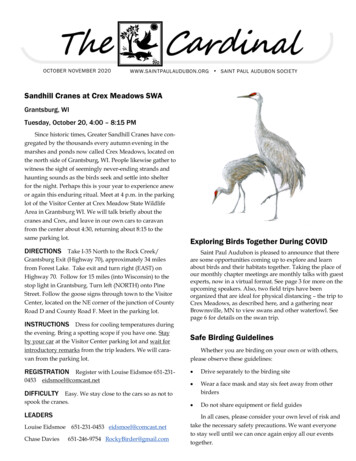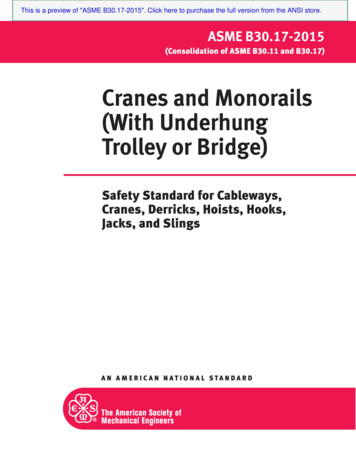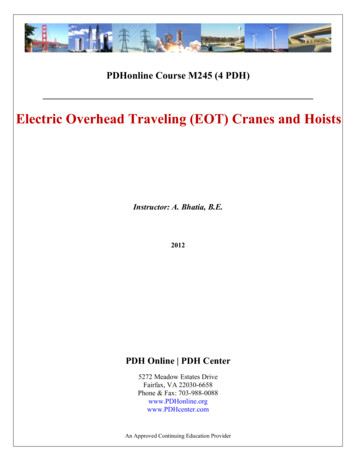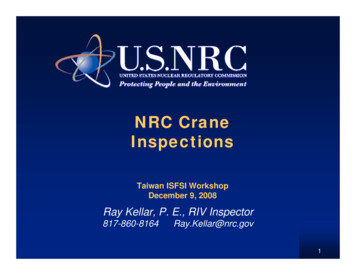
Transcription
OCTOBER NOVEMBER 2020WWW.SAINTPAULAUDUBON.ORG SAINT PAUL AUDUBON SOCIETYSandhill Cranes at Crex Meadows SWAGrantsburg, WITuesday, October 20, 4:00 – 8:15 PMSince historic times, Greater Sandhill Cranes have congregated by the thousands every autumn evening in themarshes and ponds now called Crex Meadows, located onthe north side of Grantsburg, WI. People likewise gather towitness the sight of seemingly never-ending strands andhaunting sounds as the birds seek and settle into shelterfor the night. Perhaps this is your year to experience anewor again this enduring ritual. Meet at 4 p.m. in the parkinglot of the Visitor Center at Crex Meadow State WildlifeArea in Grantsburg WI. We will talk briefly about thecranes and Crex, and leave in our own cars to caravanfrom the center about 4:30, returning about 8:15 to thesame parking lot.DIRECTIONS Take I-35 North to the Rock Creek/Grantsburg Exit (Highway 70), approximately 34 milesfrom Forest Lake. Take exit and turn right (EAST) onHighway 70. Follow for 15 miles (into Wisconsin) to thestop light in Grantsburg. Turn left (NORTH) onto PineStreet. Follow the goose signs through town to the VisitorCenter, located on the NE corner of the junction of CountyRoad D and County Road F. Meet in the parking lot.INSTRUCTIONS Dress for cooling temperatures duringthe evening. Bring a spotting scope if you have one. Stayby your car at the Visitor Center parking lot and wait forintroductory remarks from the trip leaders. We will caravan from the parking lot.Exploring Birds Together During COVIDSaint Paul Audubon is pleased to announce that thereare some opportunities coming up to explore and learnabout birds and their habitats together. Taking the place ofour monthly chapter meetings are monthly talks with guestexperts, now in a virtual format. See page 3 for more on theupcoming speakers. Also, two field trips have beenorganized that are ideal for physical distancing – the trip toCrex Meadows, as described here, and a gathering nearBrownsville, MN to view swans and other waterfowl. Seepage 6 for details on the swan trip.Safe Birding GuidelinesWhether you are birding on your own or with others,please observe these guidelines: Drive separately to the birding site Wear a face mask and stay six feet away from otherbirdersspook the cranes. Do not share equipment or field guidesLEADERSIn all cases, please consider your own level of risk andtake the necessary safety precautions. We want everyoneto stay well until we can once again enjoy all our eventstogether.REGISTRATION Register with Louise Eidsmoe 651-2310453eidsmoel@comcast.netDIFFICULTY Easy. We stay close to the cars so as not toLouise Eidsmoe 651-231-0453 eidsmoel@comcast.netChase Davies651-246-9754 RockyBirder@gmail.com
S A I N T PA U L A U D U B O N WWW. S A I N T PA U L A U D U B O N . O R GSAINT PAUL AUDUBON SOCIETY2T H E C A R D I N A L OCTOBER NOVEMBER 2020SAINT PAUL AUDUBON SOCIETY612-735-4085PO Box 7275, St Paul, MN 55107-7275PresidentDonn WaageWelcome.To the Saint Paul Audubon Society.Vice PresidentJane Braun651-636-4009Next issue: December 2020/January 2021We’re a chapter of theNational Audubon Society.Our mission is to conserve and restorenatural ecosystems, focusing on birds,other wildlife, and their habitatsfor the benefit of humanity andEarth’s biological diversity.The Saint Paul Audubon Societywelcomes everyone to become amember or participate in activities as anon-member regardless of their race,color, national origin, sex, disability,sexual orientation, marital status, age,or gender identity.Vice President,CommunicationsMartha Douglas651-227-0584TreasurerJames Stout651-645-7017SecretaryKiki Sonnen651–331-9560Conservat’n Co-ChrNancy Uppgren651-247-1718Conservat’n Co-ChrMonica Bryand651-246-5522Field Trips ChairCathy Croghan651-636-6475Education ChairDavid Kuhlmann507-514-2110Assistant EditorJackie ABOUT OUR CHAPTERFounded in 1945 as the ‘St. Paul BirdClub’ with twelve members, the Saint PaulAudubon Society now serves the entireEast Metro region of the Twin Cities, andhas around 2,800 members. Our MemberMeetings are held from Sept.-Dec. & Feb.May on the second Thursday of the month.For more info please contact leaders atleft, or visit www.saintpaulaudubon.orgA B O U T T H E C A R D I N A L The Cardinal is published 6 times a year and postedon www.saintpaulaudubon.org at t he beginning of February, April, June, August, andOctober. For information contact MarthaDouglas, editor, or Jackie Bussjaeger, assistant editor. Copy is due to the editor on the10th of the month preceding publication.The Cardinal is available free to everyone onour website. If you would like to receive anotice when new issues are ready, go towww.saintpaulaudubon.org and go to the“Newsletter” tab to subscribe with youremail address. Our Webmaster is Ben Wilson, ben@simpledesigns.biz or 651-3321362.President’s Messageyears, food companies—pushed by consumers—have begunto back this concept. Some smaller food companies, such asGrassland birds have suffered an unparalleled declineBlue Nest Beef (a partner with National Audubon), haveover the past half century, largely stemming from the wideadopted regenerative agriculture principles for years. Genspread transition of North American grasslands into farmeral Mills was probably the first big food company supporter.land. In Minnesota, more than half of our land is devoted toIt announced in 2018 that it would support a million acres inagriculture and in recent years its use has intensified withregenerative agriculture projects (https://fewer idle acres and more chemical inputs. The result is there ity/is less and less habitat on the farm for birds, mammals, orRegenerative-agriculture). In just the past two weeks comeven insects, and more chemicals drift off the farm into wamitments have been made by Tyson Foods (5 million acres)terways.and Cargill, Inc. (10 million acres).Conservationists have recognized this problem and haveRegenerative agriculture promises to work more harmoworked with farmers for at least 40 years to encourage more niously with natural systems, increase the life in soils, reduceenvironmentally friendly practices on farms. Working withchemical inputs and reduce greenhouse gases. This is a veryfarmers one on one and providing subsidies for good practic- positive development for the environment and for birds. Ines, however, has been very expensive. This expense has been the coming months we will be contacting food companies tojustified by considering these farm practices as models thatsee how we can encourage and support their efforts andother farmers would copy. Unfortunately, other farmers have study the positive impact on birds.not adopted these practices without subsidies as conservationists had hoped. These experiments therefore have been-Donn Waage, Saint Paul Audubon Society Presidentexpensive and limited.Fortunately, a new concept, “regenerative agriculture,”has been developed. The goal of regenerative agriculture isholistic--to improve the soil, water and air quality, greenhouse gas emissions, and the local economy. In the past fewRegenerative Agriculture and Birds
S A I N T PA U L A U D U B O N WWW. S A I N T PA U L A U D U B O N . O R G3Saint Paul Audubon Society InternationalMigratory Bird ProjectOur project with theUniversity of Belize to supporta migratory bird bandingstation is now underway. Belizeis a small country (only 12% thesize of Minnesota, with apopulation smaller thanRamsey County). Although asmall country, thousands ofbirds that visit Minnesota in thesummer spend most of theirlives in Belize. Our sponsored banding station is at RunawayCreek Reserve (https://runawaycreekbelize.org/). It willcapture and band birds from November 1 until the end ofMarch 2021. The object of the banding is to assess thesurvival rates of different bird species based on habitat, sexand age. The station will also evaluate the late winterphysical condition of migratory birds in their winteringgrounds. The work will help create management plans forthe conservation of birds throughout their lifespan. Finally,our contribution will also help support an outreach programat Runaway Creek Refuge for local students. We are makingplans for the University of Belize Environmental ResearchInstitute to share its experiences at the station with Societymembers.Announcing the Online Speaker Series for2020-21T H E C A R D I N A L OCTOBER NOVEMBER 2020BOARD MEETINGSThe Chapter’s Board Meetings,held the first Monday of mostmonths, have been conducted viaphone conference or Zoom. Thenext meeting will be October 5 at6 p.m.See You on FacebookJust a reminder that Saint Paul Audubon has a Facebookaccount where anyone can post photos and comments fromour upcoming field trips, to Crex Meadows on October 20 tosee the cranes, and on November 22 to Brownsville to see theswans. You might also want to post photos and commentsabout your own birding experiences.If you have a Facebook account, log in and go to https://www.facebook.com/SaintPaulAudubon.that benefits wildlife from the ground up.Now in its third growing season, the expansive prairie is startingto yield results. Reptiles and amphibians are using the newly installedwetland habitats, and pollinator surveys have shown steady increasesAlthough precautions with COVID-19 transmission means thatin abundance and diversity, with 2019 surveys finding 16 species ofwe still cannot meet in person for our traditional monthly chapterbumblebees and 25 species of butterflies. Bird surveys are also showingmeetings, we are pleased to present guest speakers every month in avirtual format, as listed below. To watch, go to saintpaulaudubon.org exciting results, as species like grasshopper sparrows and savannahsparrows are now using the restoration.on the scheduled date and click on the link provided.Join FMR ecologists Alex Roth and Karen Schik to hear about thestunning changes happening at the site, learn about theOctober 8: “Large-scale Elk River Prairie and Forest Restoration,”featuring Alex Roth and Karen Schik, ecologists with Friends of theexperimentation and partnerships that are driving conservationMississippi River (FMR). Alex and Karen will talk about the large-scale research, and see how this restoration is benefitting wildlife, waterrestoration work they are doing at the William Houlton Conservation quality, and the public.Area near Elk River. The William H. Houlton Conservation Area is a335-acre property located at the confluence of the Mississippi and Elkrivers in Sherburne County. It was one of the largest undevelopedfamily-owned riverfront properties between Elk River and Hastings.Since 2014, Friends of the Mississippi River (FMR) has been workingwith the city of Elk River to protect and restore Houlton into highquality wildlife habitat.Now, 180 acres of farm fields and degraded grassland have beenconverted to diverse native prairie and savanna habitat, and 155 acresof floodplain and mixed hardwood forests are being restored throughinvasive plant removal and native seeding and planting. This work notonly restores important habitat types that have experiencedtremendous historical decline, but replaces a monoculture system(primarily soybeans) with a high-diversity native plant community
S A I N T PA U L A U D U B O N WWW. S A I N T PA U L A U D U B O N . O R G4T H E C A R D I N A L OCTOBER NOVEMBER 20202020-21 Online Speaker SeriesNovember 12: “The Dramatic Evolution of Birds on Madagascar,” featuring Dr. Sushma Reddy, the BreckenridgeChair of Ornithology at the Bell Museum of Natural Historyand the University of Minnesota.Islands are natural laboratories to study how speciesevolve in novel environments. When species colonize newbiogeographic regions, it can expose them to new ecologicalopportunities and unique selective regimes, which can leadto the evolution of spectacular diversity. Madagascar is abiodiversity hotspot with exceptional species found nowhereelse. Here, several lineages of birds have undergone this evolutionary experiment with varying results. Some groups, likethe vangas and tetrakas, demonstrate dramatic adaptive radiations of high ecological and morphological diversity similar to classic examples like Darwin’s finches. Other specieshave persisted for millions of ears with little change. Dr.Reddy will outline her work so far in uncovering the remarkable diversity of birds on Madagascar and investigating thebiogeographic mysteries of how they got to this island.In her research, Dr. Reddy investigates biological diversity by using genetic, phenotypic, and geographic data tostudy the evolutionary history of birds. She collaborates withscientists across the world as she strives to build ourknowledge of global biodiversity patterns and aid conservation efforts.December 10: Darby and Geri Nelson, along with EditorJohn Hickman, will present “For Love of a River: The Minnesota,” which is also the title of a book by Darby Nelson, published in 2019. Together, the three will tell the heartwarmingstory of how Darby finished the book as he suffered the beginning signs of dementia. His wife, Geri, and John Hickman, the book’s editor, played key roles in getting the bookfinished and published.January 14: Dr. Sarah Hobbie, Distinguished McKnight University Professor in the Dept of Ecology, Evolution, and Behavior. Her research addresses the influence of changes inatmospheric composition, climate, land use, and plant species composition on communities and ecosystems, and theeffects of urbanization on biodiversity and water quality.February 11: Phil Hartley, photographer and naturalist, willpresent “Hidden Gems of the North Shore.” Phil will usephotography to highlight nearly two dozen great birdingspots along the North Shore that are somewhat off the beaten path and used more by locals than tourists.March 11: Marcie and Mike O’Connor will present “PrairieHaven – Prairie and Savanna Restoration on an Old Wisconsin Farm. The O’Connors bought the farm in 2000 and decided to restore the land back to the way it was before it wasfarmed. Marcie will talk about the restoration and Mike willtalk about his project of collecting recordings of birds andanimals.Sickle-billed vanga. Photo courtesy of Dr. Sushma ReddyApril 8: Lynette Anderson, Interpretive Naturalist and Restoration Assistant at Belwin Conservancy, will present“Belwin, Bison, and Birds.” She will talk about the wide variety of habitats at Belwin, most notably prairie and oak savanna, and about the introduction of a bison herd onto theirland. Belwin was founded in 1971 and launched Belwin Outdoor Science, a collaboration with Saint Paul Public Schools.Belwin has served more than 400,000 students since then andcontinues to serve over 10,000 a year, currently through virtual field trips.May 13: Rob Schultz, Audubon Minnesota executive directorand conservation team leader.
S A I N T PA U L A U D U B O N WWW. S A I N T PA U L A U D U B O N . O R G5T H E C A R D I N A L OCTOBER NOVEMBER 2020Meet Saint Paul Audubon Field Trip LeadersContinuing in our conversations with field trip leaders in the absence of group events,Linda Whyte and Louise Eidsmoe tell us more about their backgrounds and birdingexperiences. Enjoy!Linda WhyteAs a volunteer bird bander,Linda Whyte has held owlsand other raptors in herhands, but she still getsexcited with the birds at thefeeders in her yard, such asthe red-breasted nuthatchthat stopped there this falland seems intent onoverwintering.Being interested in birdsstarted early on. “It’s all myDad’s fault,” she says with a smile. Her family had a summer home inConnecticut, where her father taught the kids to keep the birds in mind ineveryday ways. “For example,” says Linda, “he placed the wren housesnear the raspberry patch so they had a source of food throughout theseasons. He left the hayloft windows open so the barn owl and barnswallows could come in. He dug a pond and mallards came. He planted avariety of trees to attract a variety of species. I learned about birds fromliving with them.”Linda’s more formal birding started in Minnesota after moving herewith her husband in 1969. They were campers and hikers and went to stateparks and learned from the rangers, which led to becoming activelyinterested in the peregrine falcon and bald eagle restoration projects. Theyalso started going on walks with Audubon and MRVAC. “Going birdingwith a knowledgeable guide is really the way to focus and learn,” she says.Linda leads or co-leads several hikes a year for Saint Paul Audubonbut that is only a fraction of the time she spends on behalf of birds. Shevolunteers for the Raptor Center doing “transport and rescue” of birds introuble, and for the Carpenter Nature Center doing raptor care. She helpsmaster banders at Hawk Ridge, Sugar Loaf Cove, and Carpenter, and didbird banding alongside an ornithologist working on a MAPS (MonitoringAvian Population Survivorship) project. One of her most memorableexperiences is the first time she pulled a great-horned owl from a cage as aRaptor Center clinic volunteer.“Raptor releases are also exciting,” she says, “because you see theresult of your work in rescuing and caring for the birds.” Many of her mostmemorable experiences were trips north to release raptors: snowy owls, anorthern hawk owl, and a great gray owl in Sax-Zim Bog, and a northerngoshawk in Grand Rapids.Linda’s father was also a role model in promoting conservation,including working to stop the use of DDT in their Connecticut town, andLinda has followed in his footsteps here too. She believes it’s important todonate and advocate for the causes you care about, volunteer to help withprojects, and stay educated about issues. A former elementary schoolteacher, she is especially concerned about educating the youngergeneration and getting them involved. “The nonprofits we support needthe energy and enthusiasm of our young people,” she says.Louise EidsmoeAlthough Louise Eidsmoe is not usually listed as the leader for fieldtrips and walks, she often fills a behind-the-scenes role, helping to organizecar pools, taking registrations, or being a contact for questions anddirections. Louise is a quintessential volunteer and joiner, always ready tohelp, and she contributes her time generously to the Saint Paul AudubonSociety. In addition to helping with field trips, she has served on the Boardfor 6 years and takes part in many of the Society’s special activities.And if Louise is not present on a walk or at a project, it’s probablybecause she’s in Guatemala, where she volunteers for the Lake AtitlanLibraries, a nonprofit that is devoted to increasing literacy in indigenouscommunities. Louise spends several months most years in Guatemalavisiting friends, and that is where she was first inspired to get into birding.“I started going in 1997, and I was seeing so many beautiful birds, such astoucans,” she says. “And then I wanted to see a quetzal, which are birdswith long green feathers that the Mayans used in the plumes on theirheaddresses.” It took several trips up the volcanic mountain where theywere before she saw one. “That is still my most exciting birding experienceever,” says Louise.After retiring in 2006 from the Wilder Foundation, where she workedfor 27 years, Louise setout to learn moreabout birding. Shejoined Saint PaulAudubon and startedgoing on a lot of fieldtrips. For beginningbirders, Louise alsorecommends joiningMOU (MinnesotaOrnithologist’s Union)or signing up on theirlistserv. “I’ve learnedabout several birdinghot spots this way,including the 180thStreet Marsh inDakota County, one of the few places where you can see yellow-headedblackbirds.”Another issue that Louise cares about strongly is native plants. “Wereally need to encourage people to grow more native plants in their yards,”she says, “and encourage the use of native plants in our parks.” Sheapplauds the recent increase in native plantings around Snail Lake, ComoLake, and the Phalen chain of lakes. “You can see the difference thismakes,” she says. “There are more insects that come around, followed by agreater number and variety of birds.”This summer Louise has been keeping an eye on a pair of trumpeterswans in Roseville’s Central Park. An avid walker, she often heads toCentral Park and having the swans there makes her walks more fun. “I liketo have one or two things in certain places that I want to keep going back tolook for. It can really spice up your routine.”
S A I N T PA U L A U D U B O N WWW. S A I N T PA U L A U D U B O N . O R G6T H E C A R D I N A L OCTOBER NOVEMBER 2020FIELD TRIPSSwans and Other WaterfowlBrownsville, MNNovember 22, 2020Swans galore are the norm just south ofBrownsville, MN. Fall migration offers birdersan opportunity to decide: trumpeter or tundraswan? Swans and dabbling ducks can be seenfrom one overlook; less than one mile away isa deep water overlook with diving waterfowl.This is a staging area for one species and isused year around for the other.From 2-3 p.m. and again from 4-5 p.m. onNovember 22, Chase and Ed Davies will be atthe Brownsville Overlook to talk about whatswans and dabbling ducks are in sight, the lifehistories of the swans, and managementchallenges of the constantly changing river.Sundown is at 4:37; the sight of swansreturning from feeding areas to congregate overnight in Pool 8is an unforgettable experience and the reason for this late-daymeeting.From 3-4 p.m., Chase and Ed will be at the Hwy 26overlook, a mile south of the Brownsville Overlook. Divingducks feed in this part of Pool 8, possible includingcanvasbacks and mergansers.Plan ahead and enjoy a “Day Along the MightyMississippi River,” and post your photos and commentsafterwards on Saint Paul Audubon’s Facebook page.TIPS: Swans are dispersed during the day but dependingon wind a bunch may be seen feeding along US 61 withinsight of the Minneiska Cemetery in MN just south of wherethe Whitewater River enters the Mississippi River; a roost sitecan be seen from a viewing platform in a park north of theBuffalo River, just north of Alma, WI.OTHER THINGS TO DO:The Eagle Center in Wabashahttps://www.nationaleaglecenter.org/Wild Wings Art Gallery in Lake City MNhttps://wildwings.com/MN Marine Art Museum in Winonahttps://www.mmam.org/Riecks Lake Park, just north of Alma, WIColvill Park, Red Wing, MN. Check out some of the pulloutsalong Lake PepinDIRECTIONSThe time and travel distance are nearly thesame whether you travel to Rochester, then use I-90, or if youtravel along the river on US 61 in MN or partly in WI to I-90.Trumpeter swans. Photo by Jackie Bussjaeger.North of LaCrescent MN, I-90 crosses the river between MNand WI. Take US 61 and/or I-90 to MN 16 South; about 3miles south of LaCrescent, on a curve stay left at junction withMN 26. Stay on MN 26 to the Brownsville Overlook, which is3 miles south of Brownsville. The Hwy 26 Overlook is another1.5 miles south of the Brownsville Overlook.INSTRUCTIONS Dress for cool temperatures and probablewinds on the river bank, including a warm hat and gloves.SAFE BIRDING GUIDELINESWear a face mask andobserve social distancing. Sharing equipment is not safe, butbring a spotting scope for your own use, binoculars, fieldguide, or a camera with telescopic lens.DIFFICULTYOverlooks are curbside to parking and arehandicap accessible.AMENITIESIn the past, Brownsville Overlook had ahandicap-accessible portable outhouse.REGISTRATIONLEADERSPlease sign in at the sites.Chase and Ed Davies, 651 246-9754,rockybirder@gmail.com
Saint Paul Audubon Society International Migratory Bird Project Our project with the University of Belize to support a migratory bird banding station is now underway. Belize is a small country (only 12% the size of Minnesota, with a population smaller than Ramsey County). Although a smal










